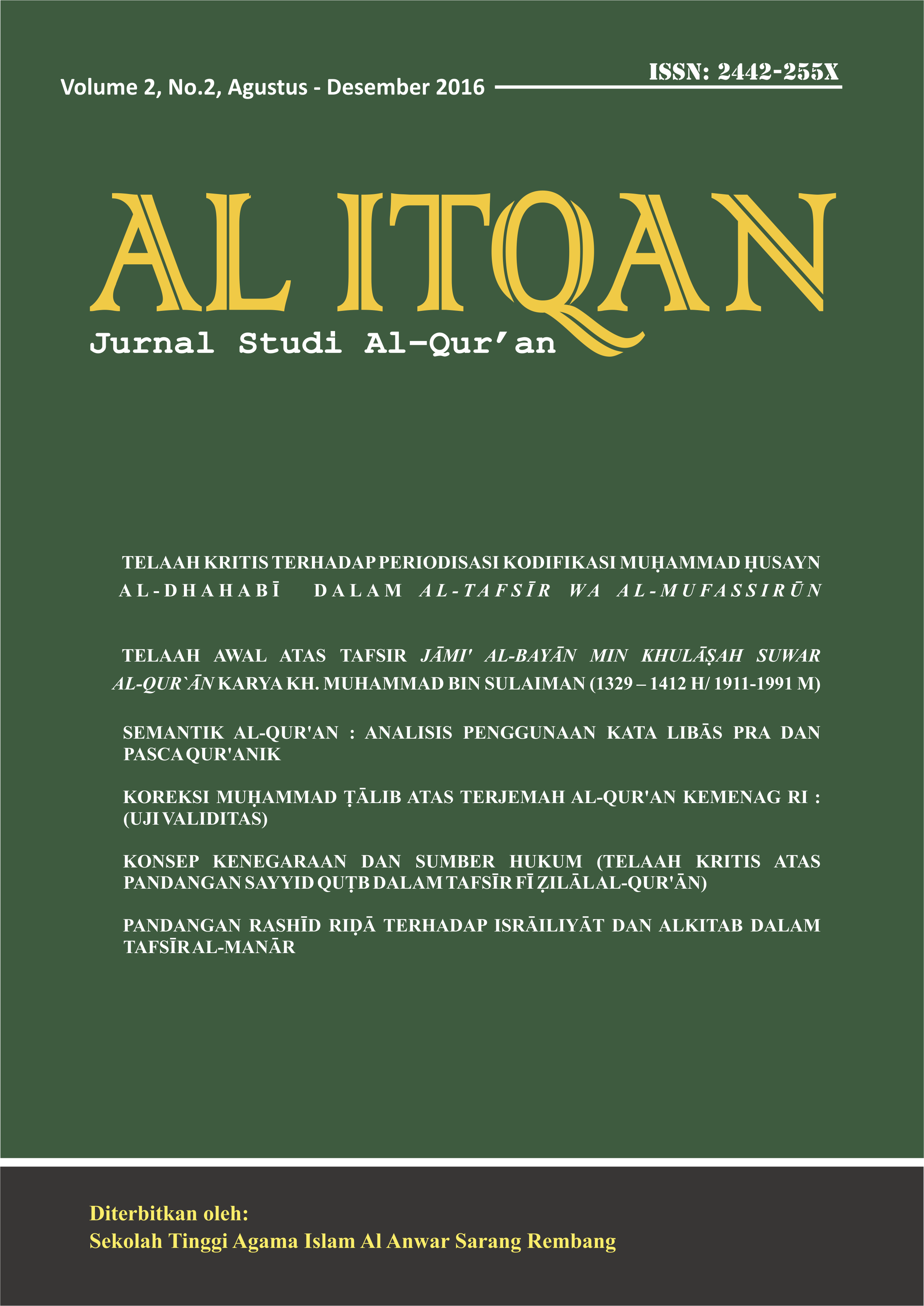SEMANTIK AL-QUR'AN : ANALISIS PENGGUNAAN KATA LIBĀS PRA DAN PASCA QUR`ANIK
DOI:
https://doi.org/10.47454/itqan.v2i2.14Abstract
This study sought to analyze the use of the word libÄs in the Qur'an. Besides plays as concepts related to everyday life, the concept of clothing in the word libÄs yet fully revealed. Many thought that libÄs in the Qur'an only have meaning as clothing. In fact, the word libÄs in the Qur'an includes of several meanings. Besides, the word libÄs be an interesting keyword to be studied in linguistic studies, especially using semantic analysis, hope, it can appearing the dynamic messages from The Koran vocabularies which is containing inside by examining analytically toward the concepts which seems to play an important role in the formation of Qur'anic vision. This paper concludes that the basic meaning of libÄs is wearing, and satara (covering). While the relational meaning that once covered later developed into an object that is used to cover (clothes). While the significance of libÄs from pre and post Qur`anic are same, that is covering. But in its development, The Koran refers to a new meaning as jewelry that used to adorn self (illegitimate). Comprehensively, the concept of libÄs from the meaning development from pre-Islam to the birth of Islam is drafted by covering something that must be covered. Indicatively, this things becomes characterizes the uniqueness of the Koran, as well as when The Koran adopts a vocabulary from pre-Islamic period which does not immediately change the meaning inside.
Key Words: LibÄs verses, Semantics, Interpretation
Downloads
References
Arsip catatan hasil Muktamar Islam Internasional mengenai “Metode Pakar Tafsir dan Penyarah Hadis†tahun 2006 di International Islamic University Malaysia.
Arslan, AmÄ«r ShakÄ«b.al-Sayyid RashÄ«d Riá¸Ä. Kairo : DÄr al-FadhÄ«lah, tt.
Al-Dhahaby, Ḥusain. al-TafsÄ«r wa al-MufassirÅ«n.tk: Mus’ab Ibn ‘Umayr al-IslÄmiyah, 2004.
Luthfiana, Nur Umi, and Nur Huda. "ANALISIS MAKNA KHAUF DALAM AL-QURAN: Pendekatan Semantik Toshihiko Izutsu." AL ITQAN: Jurnal Studi Al-Qur'an 3, no. 2 (2017): 95-118.
------------------------.IsrÄiliyyÄt fÄ« TafsÄ«r wa al-ḤadÄ«th. Kairo : Maktabah Wahbah, t.th.
Keene, Michael.Alkitab, Sejarah, Proses dan Pengaruhnya, Terj. Y Dwi Koratno. Yogyakarta: Kanisius, 2006.
MarÄghÄ« (al),Muá¹£á¹afÄ. TafsÄ«r al-MarÄghÄ«. Mesir : Shirkah Maktabah Muá¹£tafÄ al-BÄbÄ« al-ḤablÄ« wa AwlÄduh. 1365 H.
MutawallÄ«, TÄmir.Manhaj RashÄ«d Riá¸Ä fÄ« al-‘AqÄ«dah. Jedah : DÄr alMajÄ«d al-‘Usayri, 2004.
Riá¸Ä, RashÄ«d.Tafsir al-ManÄr. Mesir : Hay’ah al-Miá¹£riyah, 1990.
Rūmy (al), Fahd.Manhaj al-Madrasah al-‘Aqliyah al-Hadithah fī alTafsīr. Riyadh : Muassasah al-Risalah, 1983.
Sahin, Emad Eldin.Modernisasi Bukan Westernisasi, terj. M. Hefni. Yogyakarta : Madani Pustaka Hikmah, 2002.
á¹¢ibÄgh (al), Muhammad. LamaḥÄt fÄ« UlÅ«m al-Qur’Än Wa IttijÄhÄt alTafsÄ«r. Beirut : al-Maktab al-IslÄmÄ«, 1990.
Sugono, Dendy dkk.Kamus Besar Bahasa Indonesia. Jakarta: Pusat Bahasa, 2008.
Usman. “Memahami Israiliyat dalam Penafsiran al-Qur’anâ€, dalam Jurnal Ulumuna, Vol. 5, No. 2.
Downloads
Published
How to Cite
Issue
Section
License
Copyright (c) 2016 ‘Azzah Nurin Taufiqotuzzahro’

This work is licensed under a Creative Commons Attribution 4.0 International License.










